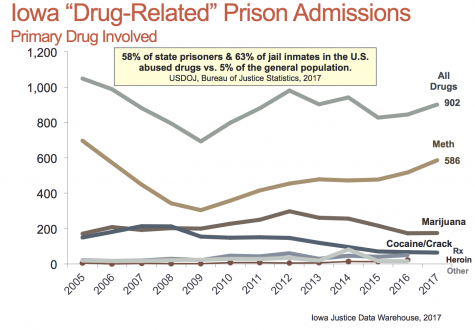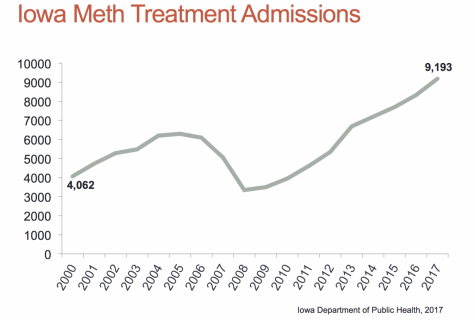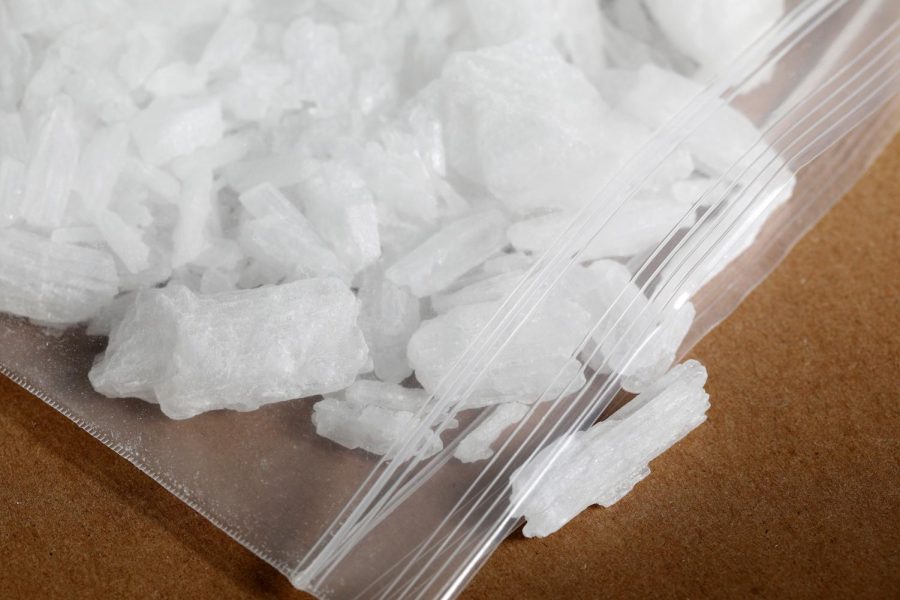Anthony Souffle/Minneapolis Star Tribune/TNS
Pure methamphetamine in rock form, known as ice, was photographed at the DEA’s North Central Laboratory in Chicago.
Methamphetamine: Iowa’s most resilient crop
Since 2004, legislators and law-enforcement officials have attempted to regulate methamphetamine production and consumption. Despite the efforts, the drug remains rampant throughout the state.
December 11, 2018
“It’s crazy, the toll it takes on people,” University of Iowa junior Ally Lowe said. “My stepbrother was the most spontaneous, funny, and giving person I knew. Then he started using meth.”
Lowe’s family has been affected immensely by methamphetamine, one of the most potent and serious drugs on the market. For Iowa in particular, meth has been one of the most sought-after substances since the early 2000s.
Lowe’s stepbrother wasn’t the only one who fell victim to the devastating drug. She said her mother, cousins, and other loved ones have all used the drug, and the effects have been noticeable and prominent. One of her cousins dropped out of school at 15 years old and is now in an abusive relationship with a drug dealer. Another cousin, 25, has been using for 10 years and has a child; because of child neglect, the child will be taken from her care. Lowe’s uncle sells opioids and started her mom’s and her cousins’ addictions.
“It’s been about 15 years now since he’s started using,” Lowe said about her stepbrother. “He’s clean as of right now and focusing on being a good father … but the temptation is always there. He’s still never been the same, he’s paranoid and still gets angry out of nowhere sometimes.”
The 21-year-old human physiology and Spanish major, while exposed to the drug and those who used it all her life, made different choices. She wishes her family had done the same.
“There’s so much more to live for,” she said. “There are so many other things out there besides meth. Live your life for yourself and your loved ones, not for a drug.”
“You’re not infinitely resilient. You’re not all-powerful,” said Peter Komendowski, the president of the Partnership for a Healthy Iowa which does outreach for current and potential drug users. “You’re not going to become a superhero or press a button to reboot your life. When you take a bad risk, it can define your entire life, and many of those risks don’t equate to a better definition.”
Meth users are prone to having intense itching because of body sores, severe dental problems that can manifest into a recognizable condition some refer to as “meth mouth,” and extreme weight loss. Violent behaviors, paranoia, and hallucinations often ensue as side effects of its use. So why would someone start using meth?
“Taking meth is like pressing the accelerator on your car until you crash down Washington Street,” Komendowski said. “Any drugs can stimulate dopamine, but when it comes to a prizefighter in the ring, none of them stand up to meth.”

Dopamine, responsible for activating pleasure and reward centers in the brain, is a major reason addicts continue to use drugs, the National Institute on Drug Abuse reports. Sugar, sexual activity, and caffeine can cause dopamine release as well, not just foreign substances such as drugs.
Komendowski said the human body was not made to have outside substances alter it, telling people that the world is better than they think.
“Meth just really gets you high,” he said. “It fools you into thinking that everything is OK when really, it’s not. The blinders we are born with are the blinders that allow us to see reality and to feel it. When things promise more than reality can allow, life falls into destruction.”
The Partnership for a Healthy Iowa, previously known as Partnership for a Drug Free Iowa, delivers educational and outreach programs to decrease high-risk behavior and influence potential users. The organization primarily focuses on drug and alcohol abuse, but it also raises awareness on internet use and positive parenting.
Despite focusing on other subjects, meth use is still a high priority for the organization.
Methamphetamine will always be available, Komendowski said. Calling it a “persistent drug,” he said there is no medical purpose for meth; it is not a prescribed substance, but users will still find ways to access it. In addition, because of the drug’s parallels to Adderall, people who need that form of medication may turn to meth as a cheaper option.
According to the American Addiction Centers, a gram of methamphetamine typically costs around $100. In comparison, 100 tablets of Adderall can cost nearly $700.
Komendowski said a big reason some young people use methamphetamine is to cope with harsh aspects of life.
“We have a generation of young people who are being bred on more dreams than reality can allow,” Komendowski said. “Taking drugs is a way to approach life with a dream. We have no capacity to live that impaired. It’s completely artificial, it’s not sustainable, and [it’s] destructive. If the context for success has been defined by something that is not obtainable, people try to find a shortcut.”
In 2004, busts of methamphetamine labs were at the highest in Iowa history.
The Iowa Department of Public Safety reported 1,500 labs that year. To combat methamphetamine usage and decrease the risk of coming into contact with potentially explosive labs, Iowa passed the Iowa Pseudoephedrine Control Law in 2004, which regulates and tracks purchases of medications with the chemical. In subsequent years, the federal government and several other states passed similar laws including the Combat Methamphetamine Epidemic Act of 2005 which regulates over-the-counter sales of pseudoephedrine, ephedrine, and phenylpropanolamine products.
Dale Woolery, assistant director for the Governor’s Office of Drug Control, explained that the control law moved pseudoephedrine — an active ingredient in many cold medicines — from over-the-counter availability to behind the pharmacy counter. While the law did not make pseudoephedrine a prescription drug or a controlled substance, similar actions were taken to control user consumption.
Taking meth is like pressing the accelerator on your car until you crash down Washington Street.
— Peter Komendowski, president of Partnership for a Healthy Iowa
The law requires pseudoephedrine buyers to be over 18 years old and must present a valid form of ID. The buyer must also sign a logbook, which coincides with a pseudoephedrine tracking system implemented by the Governor’s Office of Drug Control. The tracking system, the National Precursor Log Exchange (NPLEx), tracks purchases of pseudoephedrine in real time and flags both buyers and pharmacies that might be allowing for over-consumption or suspicious purchases. There are also limits set on how much of the product one can purchase; no more than 7.5 grams can be purchased within a 30-day period.
According to second-quarter data from 2017, NPLEx stopped 93,027 illegal sales of medicine containing pseudoephedrine that year. That equates to 245,097 grams in 33 states across the country.
“The point of the law was to tighten control and monitor inventory so that individuals with legitimate needs could access and use pseudoephedrine without any interference,” Woolery said. “While at first it was a change and a lot of people thought it was a hassle, I think most Iowans have gotten used to it and appreciate it has made a difference in the number of potentially flammable and explosive labs that could be near them.”
The form of methamphetamine production in Iowa shifted to a one-pot lab. This allows producers to take their products mobile by putting chemicals into disposable plastic bottles. Woolery explained that producers can use chemicals from hardware stores, including ammonia, acetone, and other corrosive materials.
So now, labs are not a danger to the community. Now, law enforcement has set its sights on the current suppliers of Iowa’s methamphetamine supply — foreign manufacturers and drug cartels.
While the number of labs has significantly decreased from 1,500 labs in 2004 to only 36 labs in 2017, dangers still lurk. Woolery explained that the legislature reduced the demand for homemade and domestic supplies of methamphetamine, but this caused users to search for illicit drugs from other outlets.
“The foreign supply smuggled into the state is the purest form it’s ever been, which makes it more accessible and available,” Woolery said. “There’s more of it and is relatively inexpensive, so buying that on the black market for someone who is addicted may be a lower risk proposition than making it.”
Woolery added that even in 2004, law enforcement officials told him that over 80 percent of the meth in Iowa came from Mexico. Most is for personal use in small labs, but big volumes are transported into Iowa by different methods of transportation.
“Meth is symbolic of a lot of other threats in the country,” Komendowski said. “We’ve done everything in Iowa we can to reduce the availability of meth, and yet it still finds a way here. It’s nefarious.”

But there’s one good thing about being located in the middle of the country. Tyler Schneider, who works for the Johnson County Sheriff’s Office and serves on the Johnson County Drug Task Force, said that while Iowa City and surrounding areas rely on foreign suppliers for methamphetamine, the location has decreased the amount of drugs being smuggled in. Counties closer to the Mississippi River and the Chicago area have a higher risk of drug trafficking.
Still, Schneider noted that the majority of crimes committed in Johnson County done while under the influence of methamphetamine revolve around burglary and theft. Users acquire goods that they can sell in order to have money to buy more drugs, and often pawn and sell items to support the habit.
Lowe’s stepbrother ended up in jail several times due to selling methamphetamine.
“We found out he was hiding meth behind our house because he resorted to selling it,” Lowe said. “We had to ask him to stay away. He went back and forth to jail, got another user pregnant, and was homeless for a while.”
While the numbers of arrests and methamphetamine busts have decreased, the drug still lurks.
Woolery said that around 90 percent of harm reduction, or stopping the use and production of methamphetamine, has taken place in Iowa, but the ultimate goal is to hit total reduction.
“We are pleased that we’ve had that degree of progress on this front,” Woolery said. “The big challenge that remains is the addiction piece.”
“You can’t cure your own addiction,” Komendowski said. “Nobody is really defined as an addict until they’re busted for it.”
But for meth users, treatment options are not as accessible.
According to the Iowa Public Health Department, from 2011 to 2017, methamphetamine-related deaths increased from 12 to 96, an eight-fold increase. From 2016 to 2017 alone, deaths increased by more than 23 percent.
Anthony Miller, a UI clinical professor of psychology, said that with opioids, medication-assisted treatment can be implemented, as methadone and Suboxone can be used to regulate cravings and withdrawals. Currently, such treatment is not offered for methamphetamine users.
“Lots of things have been tried, and nothing that’s available makes a difference in terms of addiction,” Miller said. “The treatments are more psychotherapeutic, and we could probably do more to develop that.”
Data from the Iowa Public Health Department show that more Iowans were admitted to hospitals for methamphetamine treatment than ever before. While treatment for cocaine users has declined steadily since 2012, nearly 10,000 Iowans were treated for meth use last year.

According to these data, that makes Iowa the national leader for meth treatment. Data from the Public Health Department, released in June, showed that Johnson County had the second-lowest rate of admissions for methamphetamine treatment with 28.5 per 100,000 people. In comparison, Wapello County saw 613.4 per 100,000 people.
“By its nature, addiction is not as visible as fires and explosions,” Woolery said. “A lot of people who suffer from addiction are not inclined to publicly talk about it, but we know that there’s a pretty significant demand and use of meth in Iowa.”
Komendowski said addiction needs to be treated from a holistic view; methamphetamine addiction does not come from any one given source, and addiction will never be curbed unless demand is stopped.
“Addiction is a disease, and we have to protect people from that,” Komendowski said. “But if we don’t look at the mental health and underlying disparities that may drive people to the point of looking for drugs, then they will find some drug. Whichever one is the easiest to find, they’ll do. Humans are creatures of habit, and dopamine is a very powerful way to get people to do that.”
If we cannot protect youth from the dangers of drugs, he said, it is necessary to teach the risks to shift their attitude toward substance abuse.
“Iowa is No. 1, or somewhere near No. 1, in corn, beans, cattle, hogs,” Komendowski said. “When farmers spot invasive weeds, they put every resource they have to keep that crop free of them. And yet, when invasive things like methamphetamine or illegal opioids affect our culture, we don’t show the same passion. We don’t think of children as important a crop as corn.”



